Modern Architectural Acoustics
Introduction
"The sensation of sound is a thing sui generis, not comparable with any of our other sensations. No one can express the relation between a sound and a colour or a smell. Directly or indirectly, all questions connected with this subject must come for decision to the ear, as the organ of hearing; and from it there can be no appeal"- Lord Rayleigh, "The Theory of Sound"

Architectural acoustics is a unique field of knowledge, combining in itself both mathematical accuracy and necessity of creative and unpredictable decisions. Being based on stringent calculations, one should pay attention to psychological and aesthetic aspects, too. Without architectural acoustics we would never be able to enjoy music in famous concert halls all over the world, hear a speech of a university’s lecturer or expressive phrases of actors at the cinema or theatres. By the way, requirements for these types of spaces are different, which will be discussed further.
These requirements are connected with the reverberation time, which is extremely important in that field of study. Reverberation is the process of sound decay due to many reflections from surfaces that absorb the energy of sound. It means that listeners not only hear the direct sound from the source, but the reflected, less intensive and delayed signal too. The more the time delay is, the weaker the reverberating sound is. Reverberation time is defined as the time needed to reduce sound pressure level by 60 dB after turning off the sound source. It is increasing with the volume of a room and decreasing with the augmentation of a square of barriers on the way of sound propagation. There is no universal numerical value for reverberation time due to difference in its length for audiences and music halls, even for every genre of musical compositions [1].
Generally, signals heard by a listener can be divided into 3 parts: direct sound, early reflections, and reverberation tail. Early reflections come in the first 50 ms from objects located nearly to the source. During this time period, the human’s ear perceives all incoming signals as one, joint with the direct sound, due to its inertia. Thereby, these early signals make the main sound more spatial, if they don’t come frontally. Later signals are heard as different sounds.
Direct signal, as well as reverberation tail, carries less than 20% of all energy of the sound, that emphasizes the importance of early reflections.
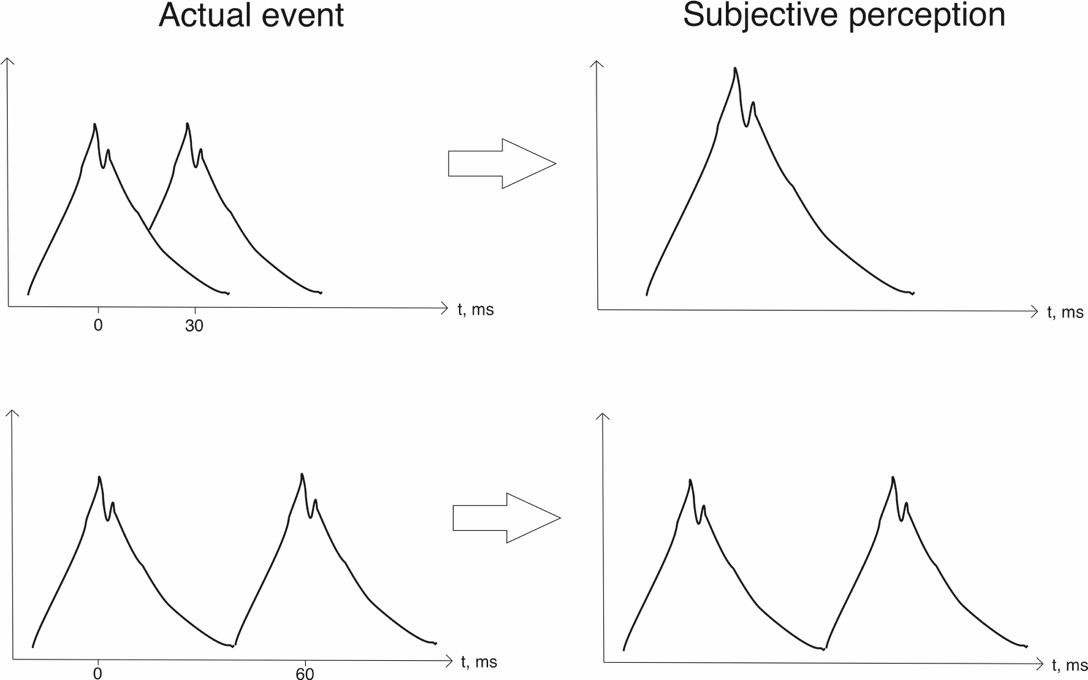
There are 3 main theories about room acoustics. Early reflections are described by geometrical theory, where laws similar to those of geometrical optics are applied. Later reflections are described by statistical theory, where all the processes are analyzed as gradual decay in the energy of waves that are reflected by barriers. Another one, the wave theory, considers processes in a room as damped natural oscillations of a huge resonator, i.e. a room [2, 3, 4].
Knowledge in the field of architectural acoustics was in use even in ancient times. One of the brightest examples is a Greek amphitheater, where was a special place called Orchestra between the scene and spectators. This place was covered by sound reflecting material that helped to achieve early reflections. Also, Orchestra was partly occupied by the choir that repeated phrases of actors, thereby performed as sound reinforcement [5].

Measurements in architectural acoustics
Let’s discuss how to carry out experiments that are necessary to evaluate the acoustical quality of different rooms. The main value we need to know is the reverberation time. However, it can’t be measured only after the construction of the whole building or concert hall! During the reconstruction of the Berlin State Opera, it was showed that the solution is to build a room model on a scale of 1:20 and take measurements on it.
Here we face another problem! Every seat in a concert hall is unique, from the point of view of acoustics. Thus, people created a device in the shape of a human’s head with receivers instead of ears, which can be placed on any seat, whether “good” or “bad” one. Thus, the small analog of this device was used in measurements on models. Electric sparks are used instead of music. In the end, we achieve an oscillogram which can be analyzed by a specialist.
It takes about 3 months to build such a model, though experiments on it can be finished in 3 weeks. It is noticeable that wavelengths used in model measurements should also be scaled as 1:20. For instance, sound with the frequency of 100 Hz is replaced by that with 2000 Hz. As for the accuracy of the model, elements smaller than 10 cm are not significant due to their negligence when compared with the wavelength of sound.
Recently, a new concert hall was built in the very heart of Moscow. Measurements on the model of “Zaradye” were carried out with the use of 20 small microphones, and the space was filled with a liquid nitrogen instead of air to scale the velocity of sound.

One should think of what can happen when mistakes are not revealed during the phase of model experiments. The negative example is David Geffen Hall (Philharmonic Hall) in New-York. It was rebuilt 5 times after its opening.
Nowadays most researches are made with computer modeling of rooms and propagation of sound in them. The development of this approach is the considerable direction of contemporary research in acoustics.
Acoustical parameters
It would be much easier if visitors of concert halls were interested in scientific results. In contrast, they are absolutely indifferent, they care about the quality of sound, it’ s fullness and audibility of violins’ pianissimo or other nuances in a particular line of every musical instrument. As about audiences, the legibility of a lecturer’s speech is of first importance.
Thereby, it was necessary to invent special parameters, which can connect theoretical calculations and experimental data with the aesthetic satisfactory of a listener. Main parameters, besides reverberation time, are:
- Clarity. It characterizes whether every note is heard distinctly, or notes tend to blur into one another
- Spatial Impression. It can be described as a ratio of the intensity of the sound from all directions to intensity of the original sound.
- Loudness.
- Balance. It describes the ratio of the loudness of a particular instrument to the loudness of all instruments.
- Timbre (tone color), i.e. how room affects the typical sound of the instrument.

Also, there are many parameters like intimacy, listener’s envelopment (LEV) and the value called interaural cross-correlation coefficient (IACC) between acoustic responses in the left and right ears that are useful. Each of these parameters is connected mathematically with sound pressure and energy of the signal.
Many observations show that listeners can be divided into 2 parts, related to their music taste. One prefers clearness and more tough increase in sound, the other likes unite and spatial sound with soft sound increase. The tough response of the room is acceptable only near the scene, so that musicians can hear each other well. This variance of taste and parameters described above are connected with the main problem of room acoustics, that can be formulated as: early reflections make the sound more transparent, however, the later ones enhance the spatiality.
Total estimation of sounding quality is also affected by non-acoustical factors, such as style and skill of performance, expected impression, that is defined by size and architectural decoration of the hall, as well as chair form, taste and musical education of visitors.
Electroacoustic modeling of sound fields
Preferences of listeners can be also evaluated by the experiment with modeling of sound fields, which I am going to describe.
Listener seats on a chair surrounded by loudspeakers, that are located 3 meters from him, in a special room. They reproduce the particular music fragment but with short delays that are made by electroacoustic means and imitate free path time of reflections. First of all, front loudspeakers play music recorded in an anechoic chamber without reverberation. Then, other loudspeakers play the same music fragments but with reverberation. The beginning of the process can be delayed for 50 ms or more, i.e. reverberation time can be varied. Signals of loudspeakers should be incoherent due to escape localization of sound, which means the existence of a particular destination of signal. The sound is totally mixed. We can observe a smooth transition from the sound without reverberation to reverberation without original sound. After all, listeners are surveyed to find the optimal reverberation time and other parameters.
From the point of view of speech, too long reverberation leads to an inability to understand what the speaker says. New syllables sound when the old ones are still on the background. For example, if the sound lasts for 3 seconds and orator speaks with the velocity of 3 syllables per second, then sound waves corresponding to 9 syllables will propagate in the room simultaneously and create total confusion and noise. That is the reason to carry out additional experiments to measure syllable intelligibility. Speaker reads a text and participants of the experiment write it down. Syllable intelligibility is defined as a ratio of correctly heard words to their general number, then the final value is calculated as the average.
Concert halls
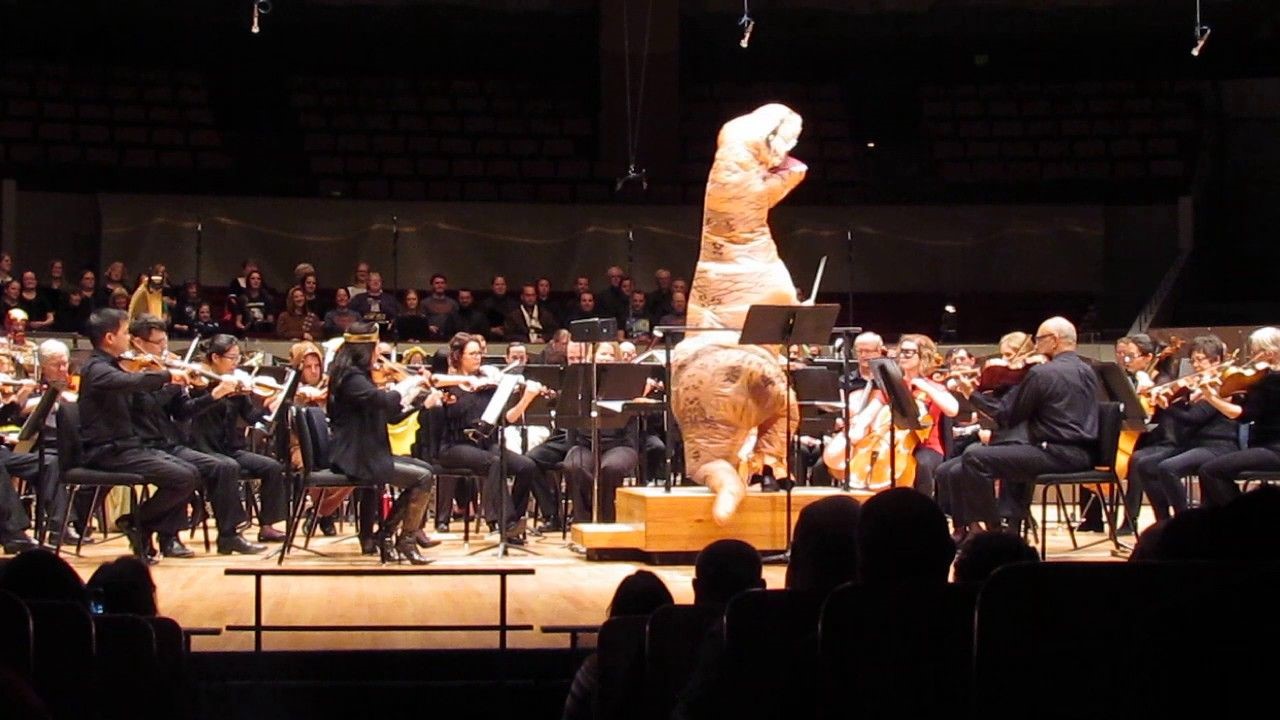
Reverberation time in concert halls differs from lecturer halls. Usually, it lies from 1,7 to 2,3 seconds, depending on requirements to other parameters. The volume per visitor is in a range from 7 to 12 m3. Let’s start by considering particular moments that should be noted when making a project of a concert hall. The first important thing is that the hall will be full of viewers. It is well known that absorption of middle and high frequencies is more intense in a room filled with people than in an empty one. High frequencies also can reflect from heads of neighbors, which are replaced with small balls in the model of the hall. These frequencies are also absorbing by air. However, they are responsible for the brightness of the sound, hence a sufficient number of high-frequency signals reflecting surfaces should be provided.

Peculiarities of design
Reflecting surfaces are walls, ceiling, floor, and additional architectural elements. Let’s discuss them separately.
Primarily I want to speak about architectural elements and how they reflect sound. Reflection can be either diffusive, i.e. scattering incoming sound, or directed in particular destination. To scatter sound, surfaces should be convex or dissected with curvature radius commensurate with a wavelength of sound. The range of human hearing is generally considered to be between 3 centimeters and 3 meters.
It is crucial to escape the formation of fields, where a sound is concentrated. It should be diffused homogeneously in the whole room. To satisfy that purpose, people use special elements with different size, depending on which frequencies they should scatter, that are usually combined with architectural elements. Supporting structures, columns, pilasters and deepenings of about 30 cm scatter middle frequencies, being transparent for low-frequency waves at the same time. Balconies with a length of around 1 meter reflect middle frequencies by geometrical laws (that is truly important because most of the sounds of music belong to the middle range), when the whole tier can be considered as a scattering element for low frequencies. As for musical instruments, the contrabasses’ typical frequency is around 100 Hz, which is corresponding to the wavelength of 3,4 meters, typical violin’s wavelength is 34 cm, that equals 1000 Hz and overtones of drum instruments have the frequency of 10 0000 Hz that is 3,4 cm wavelength. Thereby, objects smaller than 10 cm can be skipped and the tiniest important elements are relief decorations bigger than 10 cm.
In concert halls built for a large number of visitors, the sound should be scattered perfectly for the rear seats to be able to hear music. The division of walls and side balconies are necessary here, especially the last ones because they reflect sound downward to the public. Side seats are useful not only for increasing the number of audience places but for enhancement of sound quality as well.
Now, let’s discuss the back wall. Most visitors are located close to that wall on every tier. Hence, it’ s necessary that the back wall will scatter sound waves. It is also significant that without the back wall artists would barely hear the response of the audience and their own performance, though it is extremely important for musicians. However, besides diffuse reflections, specular reflections should be analyzed as well. With the help of the back wall and balconies of particular shape, sound can be directed to back rows.
The lower part of a balcony should have a shape shown in the figure 3. Arrows 2 and 3 show how sound can be directed to the back seats. In that way, the lower part of the balcony should ascend to back seats. Option 2 is used at The Leipzig Opera, for instance.

Let’ s speak about side walls and ceiling. If there are parts that scatter and reflect only middle frequencies, one should think about low frequencies, too. If they exist only in reverberation part of the signal (for instance, if the ceiling is extremely high) or reach listener’s ears too early (when reflectors are used), so the late signal will be lacking low frequencies, then the sounding will be poor and flat. In the first case, low frequencies come too late, and in the second they come too early, hence the intensity is small in both ways.
Passageways also play a significant part, since they provide the only possible reflections from the floor.
To increase the loudness of a sound in concert hall, acoustical shells are being used. They work as a shout when the orchestra is located inside. By the way, they shouldn’t direct sound right to the public, because, in that way, musicians wouldn’t be able to hear each other. The folded surface of the conch ensures necessary diffusion already in the sound formation field.
It’ s worth mentioning the main mistakes that can be faced when making a project of a concert hall.
First, there is a minimum size of the hall, connected with the required structure of early reflections. It’ s not related to the capacity of the room, though some people think that the hall can be really small if there is a little number of visitors. However, the quality of the sounding of an orchestra in halls with a low ceiling is much worse compared to those with high ceiling. Minimal height and width are about 9 and 18,5 meters, correspondingly.
Secondly, the risk of flutter echo should’ve been taken into consideration. It appears when the speaker is located between two parallel walls or under a horizontal ceiling. The solution is to form a small angle between parallel surfaces, and that will be enough to escape the risk.
Another precarious moment is planning to build a circle or elliptic concert hall. Focusing zones can occur, as well as fields that can’t be reached by sound at all or with a great delay. There is a famous effect called the effect of “whispering galleries” used in Ancient China and Rome. Whisper or any sound is moving along the walls, being silent in the middle part of the room. However, the Berlin Congress Center has a round dome. There were used huge scattering elements to escape the dangers described above.
To add on, reflections from the back wall are also dangerous because they can come back to the scene.
Generally, as it is predicted by the wave theory, halls of simple right geometric forms are less satisfying the condition of homogeneous diffusion of sound than rooms of complicated shape with non-parallel walls and different deepenings of caisson shape. The worst shape is square, the best one is the form of proportions close to the golden ratio.
Surprisingly, despite the difficult theory of the ideal concert hall, there are places with unique acoustical properties built by nature. One of them is the cave Aggtelek in Hungary that was developed in a concert hall. In spite of long reverberation time, music sounds really clear due to the special construction of the cave. Many concerts are usually held there.
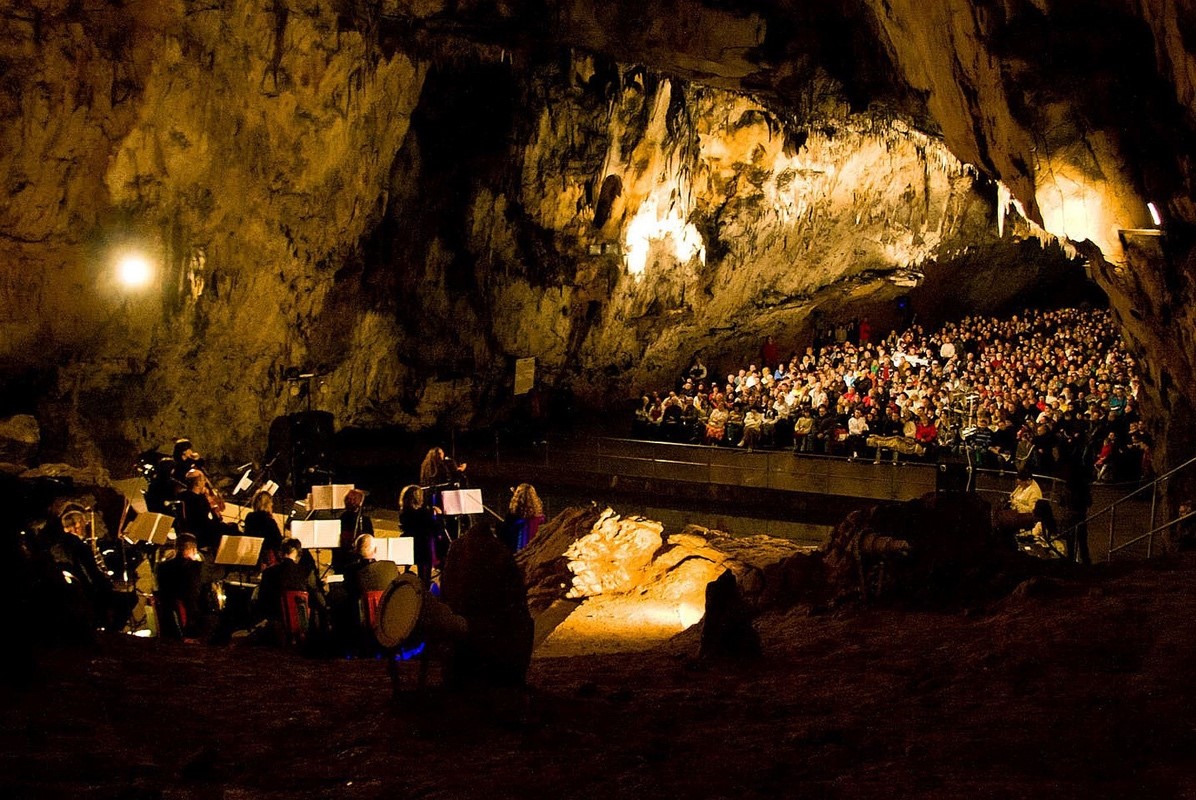
Audiences and classrooms
Volume per visitor in audiences is usually about two times smaller than in concert halls and ranges from 4 to 6 m3. The value depends on a number of students. As for reverberation time, it equals approximately 1 second and less (for music audiences it’ s about 1,4 seconds). The optimal value of reverberation time should be calculated precisely because long-lasting reverberation will mix all the words together and no one will understand the meaning. Short reverberation time is also bad because the speech of a lecturer won’t be heard from every seat.
Similar to concert halls, the number of students makes a significant impact on acoustics. However, this number can vary greater than in concert halls, hence reverberation time shouldn’t be extremely long when the audience is empty. It means that sound absorption should be have been taken into account, as well as reflection. Another difference from concert halls is that not only pupils should be able to hear the professor, and vice versa, when answering questions.

Peculiarities of design
Unlike concert halls, the floor is really important in audiences because it’ s square is a significant part of the total square of all surfaces. To absorb low frequencies, the coating of the floor is often made of two layers. Absorption of low frequencies is necessary because they mask high frequencies. Sound absorbers are also usually located on the ceiling. The back wall shouldn’t contribute to echo creation, hence the back of the class should absorb sound, too. Usually, wardrobes are placed here to satisfy that requirement.
In huge lecturer halls, the shape of parallelepiped is not appropriate. The trapezoidal shape is more beneficial due to more reflections directed to students. To achieve better sound absorption, seats are often covered with soft upholstery. Despite the important role of acoustic materials, one shouldn’t overdo with them and remember that visitors are also absorbing middle and high frequencies. Thereby, wisely distributed reflections are still a key to success.
Finally, to improve already built audiences, it is important to work in 3 destinations: diminishing reverberation time, protection from disturbing noises and avoiding echoes. Fluttering echoes is one of the most significant dangers that can be faced.
Modern tendencies in architectural acoustics
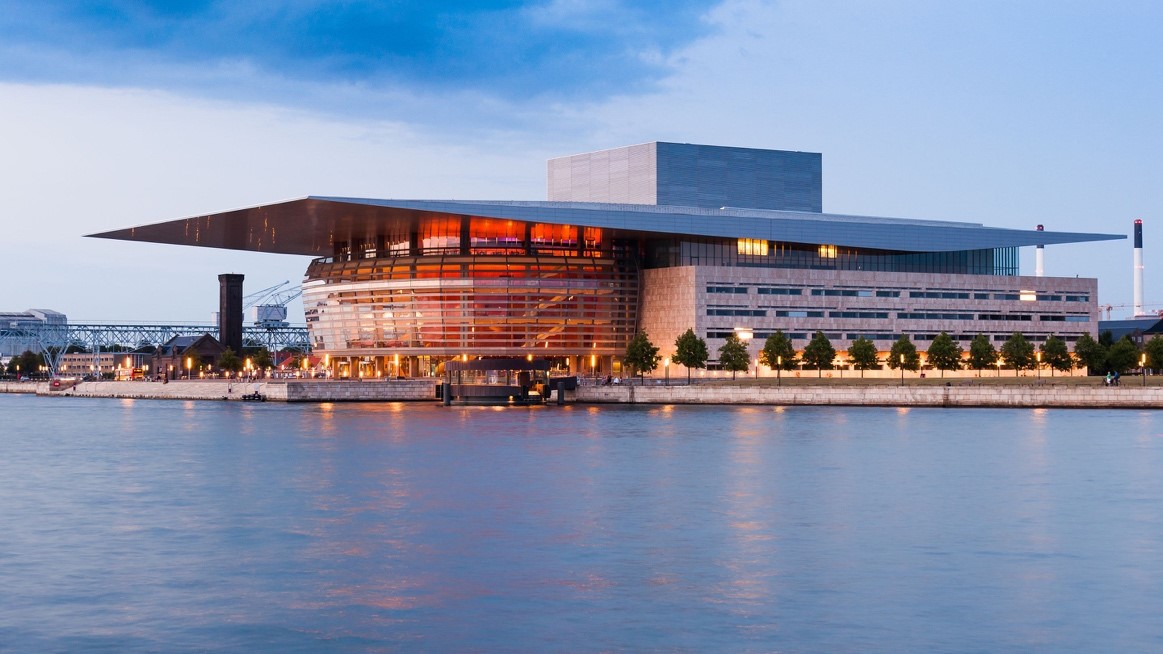
Modern tendencies in architectural acoustics are concerned about more precise and detailed calculations of parameters described in the article. It is provided by new statistical methods of analysis that allow to simulate complicated systems, and also control and generate artificial reverberation. One of the examples is the use of coded sequences [6].
More accurate data can also be obtained by the modification of measurement methods and devices. Even placing a source of sound exactly where human ears are located can improve results [7], as well as the use of 3-D sound sources to take in account every destination. Modern methods can estimate absorption coefficients of different materials depending on the angle of incidence and various conditions inside a room.
Another subject of research is the creation and study of new acoustical materials, their porosity and how these materials should be located in a room [8]. Irregularly placed materials affect acoustical parameters in a different way. Understanding of correct appliance of materials is necessary for modern recording studios.
Contemporary approaches of modeling and measurements help to understand the acoustics of ancient places. A few years ago, such research was carried out to study Stonehenge. Acoustical effects like echoes, resonances and whispering gallery were explored. The last one wasn’t found due to gaps between stones. Generally, the unique reaction of the site to sound was described as “noticeable to Neolithic man” [9].
A huge branch of acoustics has become popular due to the modern tendency to study interdisciplinary subjects. This research is connected with how music and acoustical conditions affect the physiological state of a human. Scientists study the influence of the quality of sound and reverberation time on the emotional response by means of neuroimaging. Noise effect on people is also significant to study. Such research is carried out in the Rensselaer Polytechnic Institute, where the psychological state of the hospital staff was investigated [10].
Nowadays, noises, especially made by transport systems, can change the quality of our lives. For example, they can affect health and sleep. Hence, the study of the role of urban transport and low-flying aircraft, as well as shapes of buildings, balconies and facades are truly important to be analyzed [11].
Due to the general tendency to universality, almost every city has a multifunctional hall. It is simultaneously a place for sports events, concerts, and different mass shows. Obviously, the acoustics of such spaces is way worse than of concert halls, however, due to the use of microphones and other devices, quality of sound can be improved by electroacoustic methods, and that is also one of many areas of contemporary acoustics.
Conclusion
To sum up, architectural acoustics is a truly beautiful field of science. It’ s an astonishing application for the mixture of math and aesthetics, physics and psychology. New approaches help to reach new heights, carrying out more precise experiments and considering a lot of factors, that seemed insignificant at first glance. Attention to these factors is what makes us surprised and inspired by new architectural decisions, as well as the quality of modern concert halls and audiences.
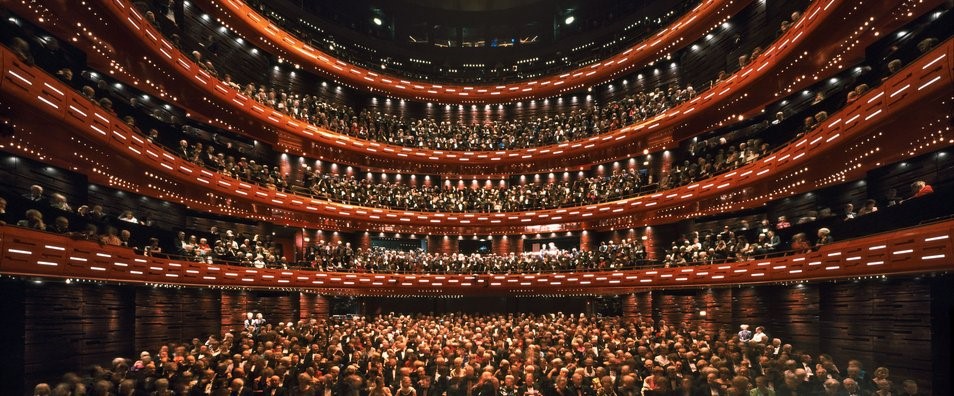
Acknowledgement

Content of the web page has been developed by Stepan Anisenko, graduate student of Lomonosov Moscow State University.
References
- Walter Reichardt, “Gute Akustik - aber wie?” (“Good Acoustics - but how?”). VEB Verlag Technik, 1979
- Makrinenko L.I., “Acoustics of Auditoriums in Public Buildings”. Moscow, Stroyizdat, 1986
- Krasilnikov V.A. “Introduction to acoustics”, published by Lomonosov Moscow State University, 1992
- John William Strutt Rayleigh, “The Theory of Sound”. 1894
- Furduev V.V. “Acoustic basis for broadcasting”. Moscow, Svyazizdat, 1960
- Daigle, J.N. and Xiang, N., "A FFT-Based Algorithm for Acoustic Measurements Using Coded Signals", Proc. International Congress on Acoustics IV, pp. 2989-2992, 2004.
- Dick, D.A. and Vigeant, M.C. (2016). “A comparison of measured room acoustics metrics using a spherical microphone array and conventional methods.” [technical report] Appl. Acoust. 107:34-45
- Sapozhkov M.A. “Room acoustics”. Moscow, Svyaz, 1979
- Bruno Fazenda, “Recreating The Sound Of Stonehenge Acoustics Of Ancient Theatres”, The Acoustics of Ancient Theatres Conference, Patras, September 18-21, 2011
- Zaman, K. Dodds, P. Xiang, N. and Barach, P. (2019): Impacts of noise on staff cognitive performance in a hospital emergency department, J. Acoust. Soc. Am., 145, pp. 1658.
- Hopkins C and Lam Y (2009) Sound fields near building facades - comparison of finite and semi-infinite reflectors on a rigid ground plane. Applied Acoustics vol 70 issue 2 pp 300-308.
